3.2 Besondere Tage

Lektionsüberblick
Special occasions like holidays and birthdays can often mean doing something different in your free time. Whether it is hunting for Easter eggs, watching a parade on the 4th of July, or celebrating your 21st birthday, you may get to experience a mix of doing familiar things and trying out something new. The focus of this lesson are on these kinds of once-a-year events and celebrations. In the end, you will be able to talk about 1) spring and summer traditions in German-speaking Europe and in Wyoming, 2) spring and summer festivals in German-speaking Europe and in Wyoming, 3) your next birthday and your dream birthday celebration.
1) Frühjahrs- und Sommertraditionen
There are a number of traditions that are celebrated in Spring and Summer in Germany, Austria, Switzerland, and Liechtenstein. Let’s begin with a holiday that is known—depending on the country or region—as Fasching, Karneval, or Fastnacht.
Fasching, Karneval, Fastnacht
| Karneval, Fastnacht und Fasching sind die drei häufigsten Bezeichnungen für die Bräuche und Traditionen, die vor der 40-tägigen Fastenzeit im deutschsprachigen Europa gefeiert werden. Es wird auch „Fünfte Jahreszeit“ genannt. Obwohl diese Jahreszeit beginnt am 11. November um 11:11 Uhr, ist die letzte Woche, die Fastnachtswoche, der Höhepunkt. Die Woche beginnt an dem letzten Donnerstag vor Aschermittwoch, der je nach Region der schmotzige oder Fette Donnerstag bzw. Weiberfastnacht ist. Es gibt auch den Nelkensamstag, den Tulpensonntag, den Rosenmontag und den Fastnachts-, Faschings- oder Veilchendienstag. Obwohl der Ursprung religiös ist, feiern viele Menschen aus anderen Gründen – zum Spaß, zur politischen Satire oder für das Gemeinschaftsgefühl. Kostüme, Masken und Paraden sind in den meisten Regionen zentrale Elemente. | Karneval, Fasching, and Fastnacht are the three most common names for the customs and traditions in German-speaking Europe that are celebrated before the 40-day season of Lent. It is also called the “Fifth Season”. Although this season begins on November 11 at 11:11am, the highpoint is the last week the Fastnachtswoche. It begins on the last Thursday before Ash Wednesday, which has a variety of regional names like Lard or Fat Thursday or Women’s Carneval. There is also a Carnation Saturday, Tulip Sunday, Rose Monday, and Shrove or Violet Tuesday. Although the origin is religious, many people celebrate for other reasons – because of the fun, the political satire or the community feeling. Costumes, masks, and parades are central elements on most regions. |
Karneval -> Word origin
Gefeiert wird Rheinland, Aachen, Bonn, Köln, Düsseldorf
|
Fasching -> Word origin
Gefeiert wird Österreich, Bayern, Berlin, Brandenburg, Sachsen
|
Fastnacht/Fasnacht -> Word origin
Gefeiert wird in Franken, Hessen, Rheinland-Pfalz, Baden-Württemberg, Bayerisch-Schwaben, Saarland, in der Oberpfalz, in der Schweiz, in Liechtenstein, Luxemburg, in Vorarlberg (Österreich) und Südtirol (Italien) |
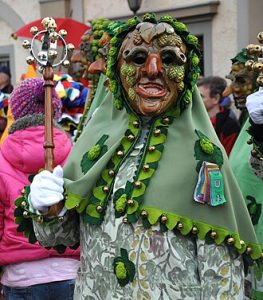 |
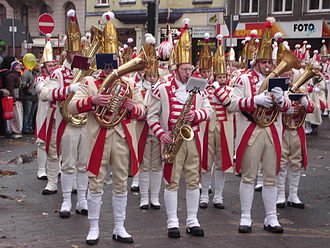 |
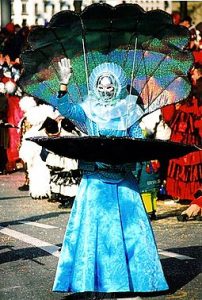 |
| Narrenfigur (fool figure), Karneval in Swabia | Karnival in Köln | Fasnachtsumzug (Fastnacht costume) in Luzern |
Liechtenstein im Blickpunkt – Fasnacht damals und heute
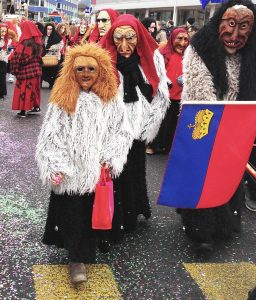
Vor 70 Jahren feierte man noch die traditionelle Beizenfasnacht in Liechtenstein (Beizen = Gasthaus). Dabei ging man in dekorierte Gasthäuser und tanzte. Oft fand man die Liebe auf der Tanzfläche. Dann änderten die Schaaner alles. 1952 gab es den ersten Fasnachtsumzug und 1969 die erste Guggamusik (=Guggenmusik = “falsch” gespielte Blasmusik). Seitdem werden immer mehr Fasnachtsbräuche und -traditionen (wie Umzüge, Maskenbälle, satirische Fasnachtszeitung) aus dem nahen Ausland importiert. Heutzutage feiert man Altes und Neues. Zum Beispiel schwärzen sich die Kinder die Gesichter noch am Schmutzigen Donnerstag an. Hier kann man den Schaaner Umzug aus 2018 sehen.
70 years ago, the traditional Beizenfasnacht was still celebrated in Liechtenstein (Beizen = tavern). One went to a decorated tavern to dance. Often, one could find love on the dance floor. Then the people of Schaan changed everything. In 1952, the first Fastnachts-parade took place and in 1969, the first Guggamusik (= music intentionally played “off-key”) was performed. Since then, more and more carneval customs and traditions (like parades, masked balls, satirical carneval newpapers) are imported from abroad. Today, old and new are celebrated. For example, children still make their faces dirty on Dirty Thursday.
Ostern
| Ostern ist im deutschsprachigen Europa ein wichtiges Fest mit religiösen und traditionellen Bräuchen. Viele besuchen Gottesdienste, besonders an Karfreitag und Ostersonntag. In katholischen Regionen gibt es Osterprozessionen. Am Ostermontag, an dem arbeitsfreien Montag nach Ostern, machen manche einen beschaulichen Spaziergang (Emmaausgang genannt). Die traditionellen Bräuche im deutschsprachigen Raum sind… | Easter is an important holiday in German-speaking Europe with religious and traditional customes. Many attend church services, in particular on Good Friday and Easter Sunday. In Catholic regions, there are Easter Processions. On Easter Monday, the work-free holiday after Easter, some go on a contemplative walk (called an Emmaausgang). The traditional customs in German-speaking Europe are… |
| Ostereier färben und suchen | Der Osterhase | Das Osterfeuer | Das Lamm |
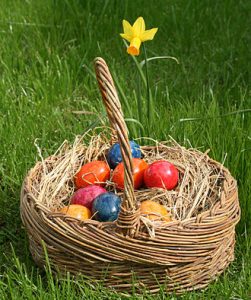 |
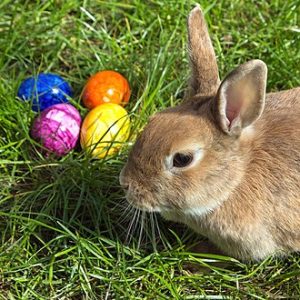 |
 |
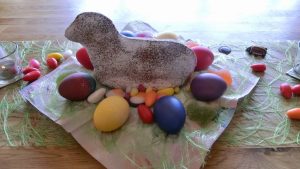 |
| Kinder bemalen Eier und suchen sie am Ostersonntag. |
Der Osterhase versteckt die Eier. | Große Feuer werden angezündet, um den Winter zu vertreiben. |
Ein Kuchen oder Braten in Lammform gehört zum Festessen. |
Christi Himmelfahrt/Vatertag
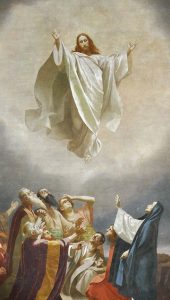 Christi Himmelfahrt Christi Himmelfahrtvon Gebhard Fugel, c. 1893 |
 |
| Christi Himmelfahrt ist ein christlicher Feiertag, der die Rückkehr von Jesus Christus in den Himmel feiert. Der Feiertag wird immer am 40. Tag nach Ostern gefeiert und fällt daher auf einen Donnerstag. Christi Himmelfahrt ist ein gesetzlicher Feiertag. | In Deutschland* wird am Christi Himmelfahrt Vatertag gefeiert. Dabei machen Männer (nicht nur Väter) traditionell einen Ausflug mit einer Kutsche oder einem Bollerwagen und trinken Bier. |
| The Feast of the Ascension is a Christian holiday that celebrates the return of Jesus Christ to heaven. This holiday falls on the 40th day after Easter, which means that it is always on a Thursday. This day is a public holiday (in German-speaking Europe). | In Germany, Father’s Day is celebrated on Christi Himmelfahrt. To celebrate, men (not just fathers) traditionally go on an outing in a carriage or hand-drawn wagon and drink beer. |
Vatertag wird in Liechtenstein am Josefstag, dem 19. März, in der Schweiz am ersten Sonntag im Juni und in Österreich am zweiten Sonntag im Juni gefeiert.
Tanz in den Mai/Maibaum
Der 1. Mai ist ein gesetzlicher Feiertag im deutschsprachigen Europa. Es ist der Tag der Arbeit. In Deutschland feiert man in der Nacht vom 30. April auf den 1. Mai “Tanz in den Mai”, ein Volksfest das ursprünglich von der Walpurgisnacht stammt. Man tanzt eben die ganze Nacht. In Teilen Deutschlands, in Österreich, Liechtenstein und in der Schweiz wird der am 1. Mai einen Maibaum aufgestellt (in manchen Regionen wird er erst an Pfingsten aufgestellt). Der Ursprung liegt in alten Frühlingsritualen, die die Natur und das neue Leben im Mai begrüßen.
Schau mal das Video einer typischen Maibaumaufstellung in Deutschland an.
Let’s practice.
Jetzt bist du dran!
Welche Frühjahrs- und Sommertraditionen in den deutschsprachigen Länder interessieren dich am meisten? Answer the question in your written journal using the modeled language above.
Then record yourself in your audio journal. If you can do it immediately without reading, that’s great! Otherwise, practice saying it a couple times before recording. Or rerecord, if you are not satisfied.
2) Frühjahr- und Sommerfeste
With the weather warming up in spring and summer, it’s a great time to attend outdoor festivals. Let’s look at some popular spring and summer festivals in Wyoming, the United States, and in Liechtenstein. Let’s start in the state you might call home.
Frühjahr- und Sommerfeste in Wyoming
What do you know about local Wyoming festivals such as Jubilee Days in Laramie or Frontier Days in Cheyenne? Read the short texts and answer the questions that follow.
Feiertage und Musikfeste in Liechtenstein
Der Liechtensteiner Nationalfeiertag – 16. Aug
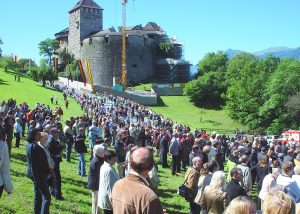
Der Liechtensteiner Nationalfeiertag wird seit 84 Jahren gefeiert. Das Datum wurde gewählt, weil der 16. August der Geburtstag von Fürst Franz Josef II. war und der kirchliche Feiertag Maria Himmelfahrt am 15. August liegt. Daher entschied man sich, beide Anlässe gemeinsam am 15. August zu feiern.
Die Feier beginnt mit einer offiziellen Zeremonie auf der Schlosswiese in Vaduz, bei der der Landesfürst und der Parlamentspräsident sprechen. Danach gibt es einen Empfang im Schlossgarten, bei dem man mit etwas Glück die Fürstenfamilie treffen kann.
Am Nachmittag findet in Vaduz ein großes Volksfest statt, und am Abend gibt es ein beeindruckendes Feuerwerk. Jedes Jahr kommen tausende Besucher aus dem Ausland, um gemeinsam mit den Liechtensteinern zu feiern.
| Die liechtensteiner Nationalhymne “Oben am jungen Rhein” lesen und hören |
| You can visit this website to learn more about this popular Volksfest (regional celebration). |
| 🎥You can watch Liechtenstein celebrate its 300-year anniversary in this video. |
Das FL1.LIFE Festival
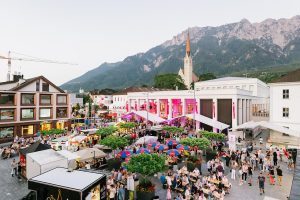
Das FL1.LIFE Festival ist das größte Musikfestival in Liechtenstein und findet jedes Juli in Schaan statt. Es gibt das Festival seit 2010. Es dauert zwei Tage und bietet Live-Musik, Kunstaufführungen und andere kulturelle Aktivitäten. Besucher aus der ganzen Region kommen dorthin.
Die Liechtensteiner Gitarrentage
Die Liechtensteiner Gitarrentage (ligita) sind ein jährliches Festival im Juli in Liechtenstein. Es dreht sich rund um die Gitarre und bietet Konzerte, Meisterkurse, Workshops und Ausstellungen.
Bekannte Gitarristen und Lehrer aus aller Welt nehmen teil. Ein besonderes Highlight ist der Wettbewerb “Gitarre Plus 1”, bei dem Gitarristen mit einem anderen Instrument oder Gesang auftreten. Die erste Runde ist online, danach gibt es Semifinal- und Finalrunden in Liechtenstein.
Jetzt bist du dran!
3) Mein nächster Geburtstag
Did you know that it is considered bad luck to offer birthday congratulations before the actual birthday in German-speaking Europe? Or that a 40-year-old bachelor (Junggeselle ) in Germany may be sent through the streets seated backwards on a donkey by his friends, because he is now ein alter Esel (an old donkey = an old man)? (That same Junggeselle receives a steer skull in parts of Austria.)
So, although some traditions might vary from region to region, one thing that is universal is the way we celebrate tends to change as we get older. In the US, the 18th and the 21st birthdays mark legal majority and the legal drinking age, respectively. In German-speaking Europe, the equivalently significant birthdays are the 16th and 18th birthdays marking the legal drinking age (beer and wine) and legal majority, respectively. We will talk about that more a little later.
Das Geburtsdatum
Before we talk more about celebrations and traditions, let’s first review how to say birthdays and birthdates. Let’s see how Julia and Max respond to questions about their birthdays/-dates. Note the differences between the way these questions are asked in German vs. in English.
| Wann hast du Geburtstag? | Wann wurdest du geboren? | |
Julia: 2. 3. 1991. |
Ich habe am zweiten März Geburtstag. | Ich wurde am zweiten März neunzehnhunderteinundneunzig* geboren. |
Max: 23. 10. 1984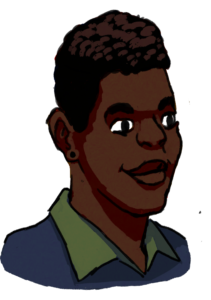 |
Ich habe am dreiundzwanzigsten Oktober Geburtstag. | Ich wurde am dreiundzwanzigsten Oktober neunzehnhundertvierundachtzig* geboren. |
*It is not important that you learn how to write out long numbers. They are written out here so that you can more easily see how they are pronounced. The blue/black text can help you identify the syllables more easily.
These numbers that show their order are called Ordinalzahlen (ordinal numbers). Just like Julia would never say in English that her birthday is on March two, but instead March second, in German we use the ordinal number to state our birthdate. Going further: You can also use this to state the month. That means, instead of Julia saying “Ich wurde am zweiten März 1991 geboren,” she could say “Ich wurde am zweiten dritten 1991 geboren.” The dritten is the third month, March.
Let’s practice more birthdates!
Wie feierst du? Interviews über Geburtstagstraditionen
In the following video, Evi and Karl talk about how they celebrate their birthdays. Watch their interviews and check your listening comprehension with the questions that follow.
Geburtstagstraditionen in der Schweiz, Deutschland, Österreich, und Liechtenstein
Der 16. Geburtstag marks the first legal drinking age for beer, wine, and champagne. Mit Sekt anstoßen, to raise one’s glass to someone’s health, is a common tradition in German-speaking Europe and the birthday child may do so for their first time on their 16th birthday. Einmehlen or panieren (breading) is a more recent 16th birthday tradition in some areas of Northern Germany. Geburtstagskind receives flour (Mehl) dumped on their head. Sometimes the flour is mixed with beer and/or eggs. You can read more about Einmehlen here.
Der 18. Geburtstag marks the Volljährigkeit (legal majority) for the Geburtstagskind. They may now imbibe all kinds of alcoholic beverages, but, even more importantly, they may vote. Volljährigkeit means more privileges and responsibilities in der Schweiz, in Deutschland, Österreich, Liechtenstein. (Since spring 2024, one significant difference between the four countries: recreational use of cannabis is legal only in Germany.) The driving age used to be 18 in German-speaking Europe, but in the last 15-20 years it has been moved to younger ages. In Switzerland, Germany, and Liechtenstein, a 17-year-old can earn a learner’s permit (Führerschein auf Probe), which allows them to do “Begleitetes Fahren” (attended driving), whereby the attendant must be at least 30, have had a driver’s license for at least 5 years, and few or no points on that license. In both Germany and Liechtenstein, once a person turns 18, they can earn their “full” Führerschein and drive alone. In Switzerland, a new driver between the ages of 17-20, must complete one year of begleitetes Fahren before they can qualify for a regular Führerschein. In Austria, a 17-year-old can drive without an attendant, once they have completed 3000km (ca. 1900mi) of begleitetes Fahren.
Der 25. Geburtstag – wenn man unverheiratet ist (when one is unmarried) – In some parts of Germany, unmarried people are jokingly poked fun at for their single status, with men, now an alte Socke, receiving a wreath of old socks and women, now an alte Schachtel, receiving a wreath of old cartons, like empty cigarette packs. There is even a website specializing in the sale of these Sockenkränze and Schachtelkränze! (The authors are earning no kick-backs for this mention.) As attitudes about marriage change, this tradition has morphed into one marking the birthday of any friend you may deem an alte Socke or alte Schachtel, regardless of marital status.
Der 30. Geburtstag – wenn man unverheiratet ist – All over Germany and Austria (and perhaps beyond), unmarried newly 30-year-old men are jokingly poked fun at or publicly shamed for not being married or engaged. The tradition began in 1890 in Bremen with unmarried men having to sweep the steps of the Bremer Cathedral, which prompted the tradition to be called Domtreppenfegen (Cathedral steps sweeping), although many other kinds of steps, or even city squares or bridges, can be swept. In this tradition, sand and sawdust are spread out for the man to sweep up with a broom that is missing most of its brushes. He can only be freed by a kiss from an unmarried woman. This tradition has spread to Austria, where it is called Kehren (another word for Fegen), and even to Barcelona and Boston.
Der 30. Geburtstag – wenn frau unverheiratet ist – Women generally do not do Treppenfegen or Kehren, except during Schaltjahr (leap year) in some areas. Instead, the tradition for the unmarried 30-year-old woman is Klinkenputzen, whereby she must clean the Türklinken (door knobs) of the Cathedral (or other location) until she is freed by a kiss from an unmarried man. Naturally, neither of these traditions can take place without the Geburtstagskind agreeing to it and local authorities approving of the steps or door knobs being made messy.
Der runde Geburtstag, the birthday ending with a “zero”, especially as one gets older. The birthday celebrations in Germany are generally organized by and paid for by the Geburtstagskind. If you are invited by a Geburtstagskind to a dinner on their birthday, you will usually not be allowed to pay for your meal. You are also expected to bring in some kind of sweet treat to work or school on (or after, never before) your birthday. The “round” birthdays can be celebrated in a much larger way with people traveling significant distances to spend the day, evening, and into the night with their loved one.
In parts of Austria such as Kärnten, the runde Geburtstag is celebrated with Niederlegen. In the night before the birthday, the Geburtstagskind is brought ein Nachtgewand (pajamas), eine Zahnbüste, einen Nachttopf (chamber pot), and eine Kerze (candle) as well as food and beverages. Before the friends enter the house, they sing Ständchen (serenade). Then they dress the Geburtstagskind in the pajamas and they ceremoniously handover the chamber pot and candle. At the end of the Niederlegen, the Geburtstagskind uses the toothbrush and the friends sing lullabies. Naturally, no-one says “Alles Gute zum Geburtstag” until midnight.
Another Austrian tradition for the runde Geburtstag are the creation of Strohpuppen, straw dolls like scarecrows, which are dressed up and posed to resemble the Geburtstagskind. You can see a picture of this tradition here.
Reinfeiern, when the party starts on the birthday eve. The Niederlegen from Austria is a Reinfeiern. Celebrating this way is especially popular when one is younger and when the birthday is on a Sunday. Then you can have your birthday party on Saturday, but no-one congratulates you until midnight. They are really very strict about this!
| Now read and listen as Sebi talks about how he will celebrate his next birthday. | Claudia likes to dream big. We asked her what she would do for her dream birthday party. Read and listen as she talks about how she would celebrate her next birthday if she could go all out. |
 |
 |
| Nächste Woche werde ich 23. Zum Geburtstag werde eine kleine gemütliche Feier mit meiner Familie und meiner Freundin haben. Wir werden ein besonderes Gericht gemeinsam zubereiten und genießen. Danach werden wir einen leckeren Kuchen essen. | Was würde ich für mein Traumparty tun? Ich würde mit meinen besten Freunden aus aller Welt in mein Lieblingsrestaurant gehen. Danach würden wir tanzengehen. Ich brauche keine Geschenke, aber ich weiß, dass meine Freunde mir Blumen und Schokolade schenken würden. Das würde mir gefallen! |
Jetzt bist du dran!
Wie wirst du deinen nächsten Geburtstag feiern? Wie würde deine Traumparty aussehen? Answer the question in your written journal using the modeled language above.
Then record yourself in your audio journal. If you can do it immediately without reading, that’s great! Otherwise, practice saying it a couple times before recording. Or rerecord, if you are not satisfied.
Jetzt kombinieren!
Let’s put it all together now. Take a look at the events and celebrations below. Can you name what they are? What do you see in the picture? Willst du diese Traditionen und Feste mitfeiern? Warum (nicht)? In your written journal, answer these questions stating which traditions and festivals you would like to participate in and which ones you would not.
 |
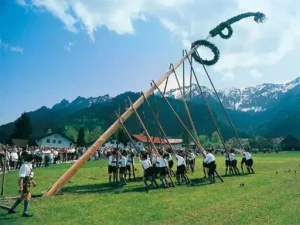 |
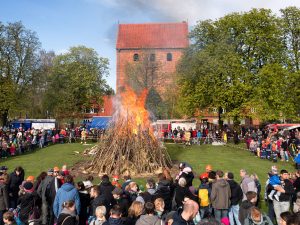 |
 |

Media Attributions
- Maibaum Video Aufrichten des Maibaums in Altenholz 2015 by Philipp Neuenfeldt, licensed under CC BY 4.0 International License.
Media Attributions
- 2030-2040 fl banner large is licensed under a CC BY-NC-SA (Attribution NonCommercial ShareAlike) license
- Photo of Narrenfigur, public domain
- Photo of Karnival in Köln by Neva Micheva, CC BY 2.5
- Photo of Fasnacht costume by Roland Zumbühl, CC BY-SA 3.0
- Fasnachtsumzug Liechtenstein 2014 Hellebardius flickr © Hellebardius is licensed under a CC BY-NC-ND (Attribution NonCommercial NoDerivatives) license
- Photo of Ostereier by Toelstede, CC BY-SA 3.0
- Photo of Osterhase by Superbass, CC BY-SA 4.0
- Photo of Osterfeuer in Berlin by Adva, CC BY-SA 3.0
- Photo of Osterlamm by Amboss-Blog, CC BY-NC-ND 3.0 DE
- Photo of Christi Himmelfahrt, public domain
- Photo of Liechtensteiner Nationalfeiertag by Hellebardius, Flickr, CC BY-NC-SA 2.0
- Photo of FL1.LIFE Festival by Julikon, CC BY-SA 4.0
- Photo of Sebi adapted from pexels-chuchuphinh-1329494
- Photo of Maibaum Aufstellung by Cultius Culturals, CC BY NC 4.0, https://cultiusculturals.wordpress.com/2017/06/28/santa-valpurga-i-la-nit-de-les-bruixes/maibaum-bad-reichenhall/
- Photo of Osterfeuer in Berlin by Adva, CC BY-SA 3.0



